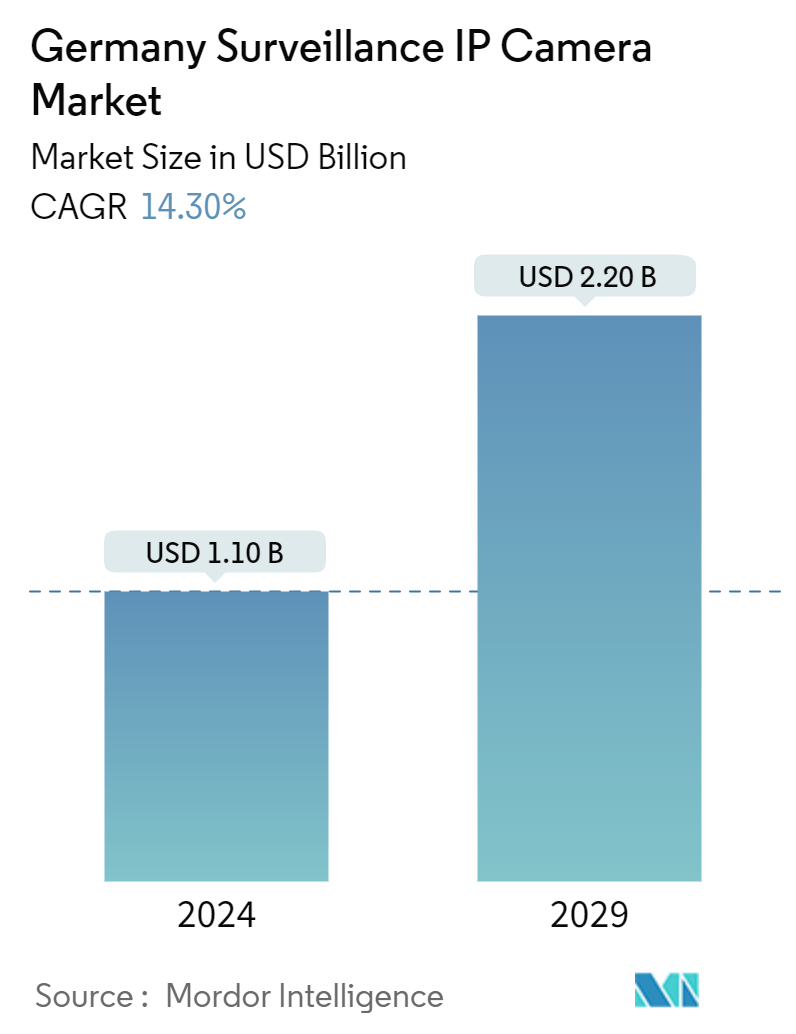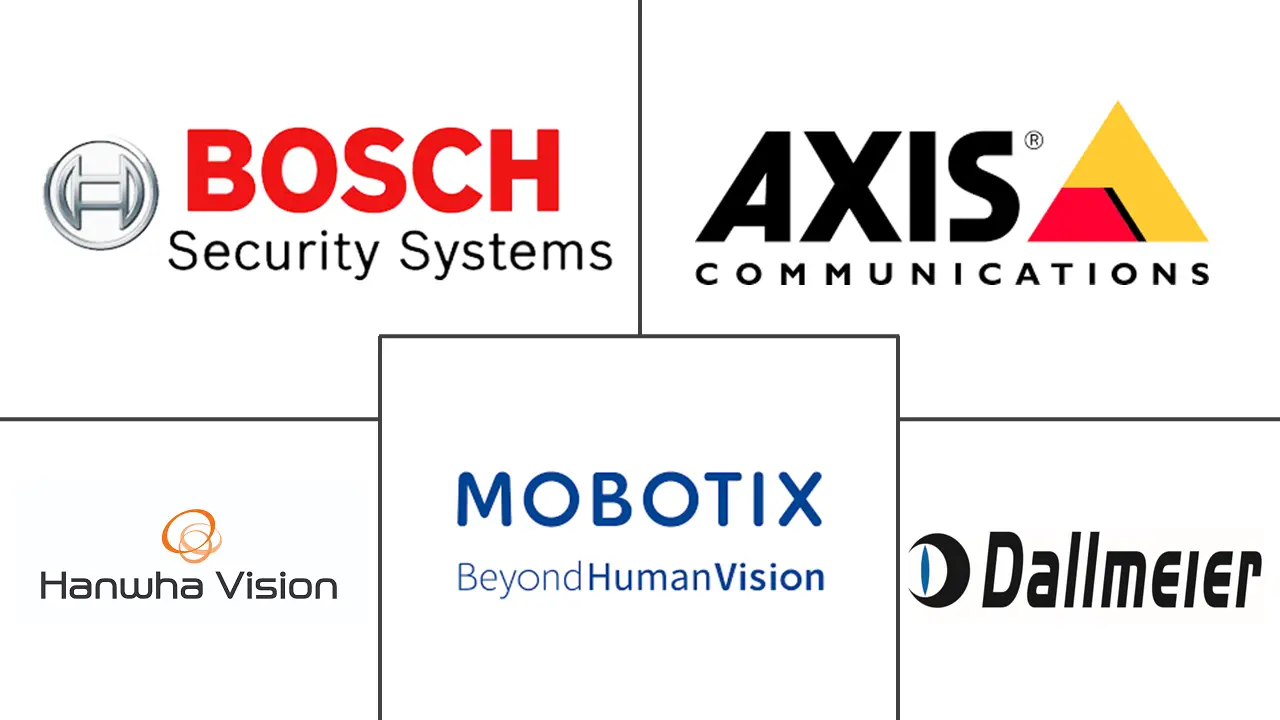Market Size of Germany Surveillance IP Camera Industry

| Study Period | 2019 - 2029 |
| Base Year For Estimation | 2023 |
| Market Size (2024) | USD 1.10 Billion |
| Market Size (2029) | USD 2.20 Billion |
| CAGR (2024 - 2029) | 14.30 % |
| Market Concentration | Low |
Major Players
*Disclaimer: Major Players sorted in no particular order |
Germany Surveillance IP Camera Market Analysis
The Germany Surveillance IP Camera Market size is estimated at USD 1.10 billion in 2024, and is expected to reach USD 2.20 billion by 2029, growing at a CAGR of 14.30% during the forecast period (2024-2029).
- Germany witnessed a series of high-profile terrorist attacks, with 2023 marking the uncovering of two significant right-wing terrorist plots. This surge in terrorist activities prompted federal and state governments to bolster public safety measures. Consequently, they ramped up investments in surveillance technologies, particularly IP camera systems. As a result, IP camera networks now blanket urban centers, transportation hubs, and key public areas.
- Major German cities, such as Berlin, Munich, and Hamburg, have launched comprehensive smart city programs that integrate IP camera systems with other smart technologies. These initiatives aim to improve traffic management, environmental monitoring, and public service delivery, leveraging the capabilities of IP camera systems for data collection and analytics. For example, the city of Hamburg implemented an extensive IP camera network as part of its "Smart City Hamburg" program, which includes features like license plate recognition and crowd monitoring.
- The demand for IP camera systems in Germany is surging, primarily led by the robust manufacturing and industrial sectors, which are pivotal to the nation's economy. These IP cameras are a common sight in production plants, warehouses, and key infrastructure, playing a crucial role in asset monitoring, anomaly detection, and bolstering worker safety. Industries like automotive, chemicals, and energy, where safeguarding sensitive data is critical, are at the forefront of this adoption.
- Germany's stringent privacy laws, notably the Federal Data Protection Act (BDSG), have presented hurdles for IP camera system deployments. These regulations establish rigorous personal data collection, storage, and utilization criteria. Consequently, manufacturers and users alike must bolster their data security protocols. As a result, organizations in Germany are proceeding cautiously with the adoption of IP camera systems, given the intricate legal landscape.
- The Russia-Ukraine War directly affected supply chains, leading to significant disruptions in the availability and distribution of electronic components, especially those essential for manufacturing IP cameras. As a result, shortages, shipment delays, and price escalations have become prevalent in the IP camera market. This effect is most acutely felt in European countries that rely heavily on imports.
Germany Surveillance IP Camera Industry Segmentation
Internet Protocol (IP) or network cameras facilitate digital video surveillance by transmitting and receiving footage over the internet or a local area network (LAN). IP cameras link to a network through Wi-Fi or a Power over Ethernet (PoE) cable. The market size is gauged by monitoring revenue from the sales of various surveillance IP camera types, catering to multiple applications. Market trends are discerned through scrutinizing investments in product innovation, diversification, and expansion. Moreover, the study delves into the macroeconomic factors that influence the market.
Germany's surveillance IP camera market is segmented by the end-user industry (government, banking, healthcare, transportation, logistics, industrial, and others [education institutions, retail, and enterprises]). The report offers market forecasts and size in value (USD) for all the above segments.
| By End-user Industry | |
| Government | |
| Banking | |
| Healthcare | |
| Transportation and Logistics | |
| Industrial | |
| Other End-user Industries (Education Institutions, Retail, and Enterprises) |
Germany Surveillance IP Camera Market Size Summary
The Germany Surveillance IP Camera Market is experiencing significant growth, driven by increased investments in public safety and smart city initiatives. The rise in terrorist activities has prompted both federal and state governments to enhance security measures, leading to widespread adoption of IP camera systems across urban centers and critical infrastructure. Major cities like Berlin, Munich, and Hamburg are integrating these systems into their smart city programs, which aim to improve traffic management and public service delivery. The manufacturing and industrial sectors, crucial to Germany's economy, are also contributing to the demand for IP cameras, as these systems play a vital role in asset monitoring and enhancing worker safety. However, stringent privacy laws and regulatory requirements pose challenges, necessitating robust data security protocols.
The market is further influenced by the ongoing shift towards Industry 4.0, with IP cameras being integrated into smart factories alongside other technologies. This transition is driven by the need for enhanced image clarity, scalability, and integration with industrial automation platforms. The competitive landscape is marked by the presence of both global and local players, who are investing in innovation and strategic partnerships to maintain their market positions. Recent advancements include the introduction of AI-driven cameras and partnerships to enhance product availability. Despite supply chain disruptions due to geopolitical tensions, the market is poised for continued expansion, supported by regulatory mandates and the growing emphasis on security in industrial and critical infrastructure sectors.
Germany Surveillance IP Camera Market Size - Table of Contents
-
1. MARKET INSIGHTS
-
1.1 Market Overview
-
1.2 Industry Attractiveness - Porter's Five Forces Analysis
-
1.2.1 Threat of New Entrants
-
1.2.2 Bargaining Power of Buyers
-
1.2.3 Bargaining Power of Suppliers
-
1.2.4 Threat of Substitute Products
-
1.2.5 Intensity of Competitive Rivalry
-
-
1.3 Industry Value Chain Analysis
-
1.4 An Assessment of Macroeconomic Trends on the Market
-
-
2. MARKET SEGMENTATION
-
2.1 By End-user Industry
-
2.1.1 Government
-
2.1.2 Banking
-
2.1.3 Healthcare
-
2.1.4 Transportation and Logistics
-
2.1.5 Industrial
-
2.1.6 Other End-user Industries (Education Institutions, Retail, and Enterprises)
-
-
Germany Surveillance IP Camera Market Size FAQs
How big is the Germany Surveillance IP Camera Market?
The Germany Surveillance IP Camera Market size is expected to reach USD 1.10 billion in 2024 and grow at a CAGR of 14.30% to reach USD 2.20 billion by 2029.
What is the current Germany Surveillance IP Camera Market size?
In 2024, the Germany Surveillance IP Camera Market size is expected to reach USD 1.10 billion.

